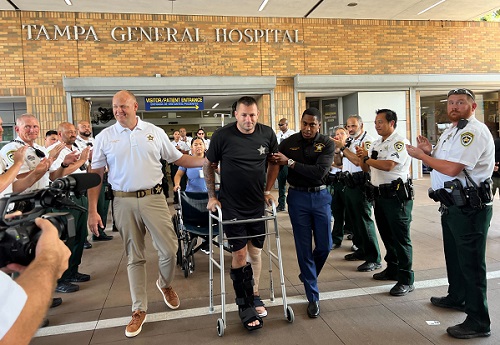Rural Health Crisis: Arizona’s Widening Mortality Rate Gap
Matthew Roach, who has spent two years as vital statistics manager for the Arizona Department of Health Services and ten years in its epidemiology department, has noticed a pattern in mortality rates that has rural health specialists concerned.
As Roach examined Arizona citizens’ health, the disparity between rural and urban mortality rates widened.
The health disparities between rural and urban Americans have long been recognized, but a recent research from the USDA’s Economic Research Service shows that the gap has widened in recent decades. USDA researchers discovered that rural Americans aged 25 to 54 die at significantly greater rates from natural causes, such as chronic diseases and cancer, than the same age group residing in cities. The investigation excluded external reasons of mortality, such as suicide or accidental overdose.
- Auto Insurance Shopping Rises in Response to Soaring Insurance Rates: Report
- Avoid These 7 Missteps When Refinancing to a Lower Mortgage Rate
- Rising Home Prices Amid Slight Mortgage Rate Dip: Analysis
- Fresno County’s Groundbreaking Initiative: $500 Monthly Payments in New Guaranteed Income Program, Here is Who is Eligible
- Unlocking Financial Freedom: 5 Reasons to Opt for Personal Loans in Credit Card Debt Repayment
The study studied death data from the Centers for Disease Control and Prevention for two three-year periods: 1999 to 2001 and 2017 to 2019. In 1999, the natural-cause death rate for those aged 25 to 54 in rural areas was only 6% higher than that of city inhabitants of the same age. By 2019, the disparity had widened to 43 percent.
The researchers discovered that the widening gap was caused by a fast increase in the proportion of women living in rural areas who died young from treatable or preventable diseases. During the study period, women in this age range witnessed an 18% increase in natural-cause death rates in counties without an urban core population of 10,000 or more, compared to their male counterparts, who experienced a 3% increase.
- Will Everyone Get a $12,000 Stimulus Check in 2024? Find Out Eligibility
- $6400 Stimulus Checks in 2024: What You Need to Know About Eligibility and Payment Dates
- IRS 4th Stimulus Check 2024: Comprehensive Guide to Eligibility and Payment Dates
- 3 Smart Moves to Make Once Your Savings Reach $50,000, Here Are Crucial Actions to Take
- 3 Effective Ways to Pay Off Student Loans on a $50K Salary or Less, Know Here!
Cancer and heart disease were the main natural causes of mortality among men and women of prime working age in both rural and urban areas. The incidence of lung disease among women in distant sections of the country increased the most when compared to rates in metropolitan areas, followed by hepatitis. Pregnancy-related fatalities also had an impact, accounting for the highest rate of natural-cause mortality among women aged 25 to 54 in rural areas.
The unfavorable trends for rural non-Hispanic American Indian and Alaska Native individuals were particularly noticeable. According to the data, Native Americans aged 25 to 54 experienced a 46% rise in natural-cause mortality during the previous two decades. Native women experienced a 55% increase in mortality rates over the two study periods, whereas non-Hispanic White women saw a 23% increase.
The rural-urban divide widened in all sections of the country but was most pronounced in the South. According to the study’s authors, rising death rates indicate deteriorating population health, which might impact local economies and jobs.
As access to and quality of health care in rural areas deteriorates, rural health specialists believe the USDA results should encourage stronger rural health legislation. Alan Morgan, CEO of the National Rural Health Association, called the research “shocking,” but “unfortunately, not surprising.”
Morgan believes that inequality needs greater attention from state and national policymakers. The study does not address the causes of the rise in mortality rates, although the authors do acknowledge that disparities in healthcare resources may jeopardize the accessibility, quality, and affordability of care in rural areas.
Hospitals in tiny and distant communities have long suffered, and ongoing closures or conversions limit healthcare provision in many areas. The authors point out that chronically greater rates of poverty, disability, and chronic disease in rural areas, along with fewer physicians per capita and hospital closures, harm community health.
Roach said his previous employment as an epidemiologist involved working with social vulnerability indexes, which use income, race, education, and access to resources such as housing to assess a community’s resilience to negative health consequences. A map of Arizona reveals that rural counties and reservations have some of the greatest vulnerability levels.
According to Janice C. Probst, a retired professor at the University of South Carolina whose work focuses on rural health, many current rural health activities are aimed at sustaining hospitals, which she notes are critical sources of health care. However, she stated that this may not be the most effective strategy to reduce injustices.
“We may have to take a community approach,” said Probst, who studied the report before its publication. “Not how do we keep the hospital in the community, but how do we keep the community alive at all?”
Probst was struck by the demographic inequalities, as well as another factor. She stated that the states with the highest rates of natural-cause mortality in rural areas were South Carolina, Mississippi, Georgia, Alabama, and others that have not expanded Medicaid, the joint federal-state health insurance program for low-income people, despite efforts to expand it in some states, particularly Mississippi.
The USDA researchers also make this observation.
“Regionally, differences in State implementation of Medicaid expansion under the 2010 Affordable Care Act could have increased implications for uninsured rural residents in States without expansions by potentially influencing the frequency of medical care for those at risk,” they stated in their report.
Wesley James, founding executive director of the University of Memphis’ Center for Community Research and Evaluation, said state politicians might help alleviate some of the issues by campaigning for Medicaid expansion in their states, which would boost access to health care in rural areas. A vast number of people want it, but officials aren’t listening to them, he claims. James also reviewed the report before its publication.
According to KFF polls, two-thirds of individuals in non-expansion states want their state to extend its health insurance program.
Morgan explained that the study concentrated on deaths that happened before the COVID-19 pandemic, which had a catastrophic impact in rural regions.
“COVID changed the nature of public health in rural America,” he told me. “I hope that this prompts Congress to direct the CDC to look at rural-urban life expectancies during COVID and since COVID to get a handle on what we’re seeing nationwide.”
According to Roach, COVID-19 will be the main cause of mortality for adults aged 45 to 64 in Arizona, both rural and urban, in 2021.











